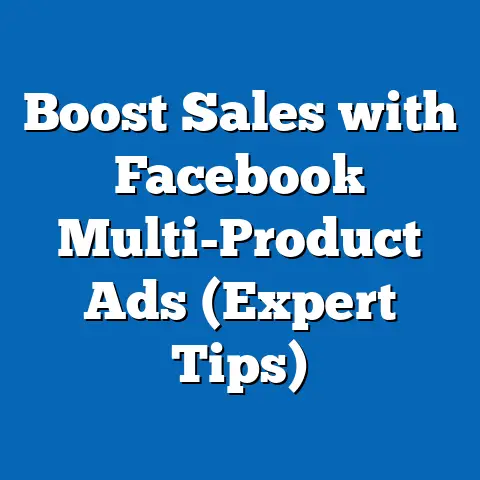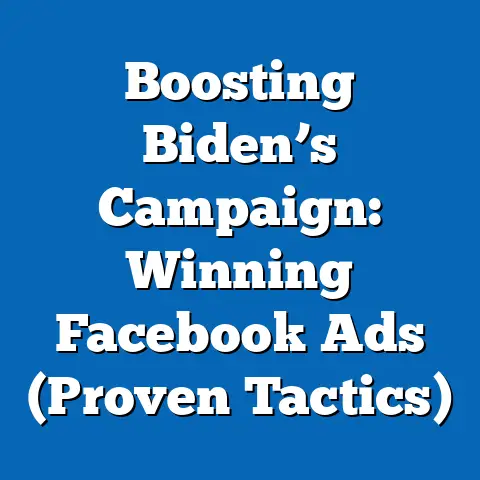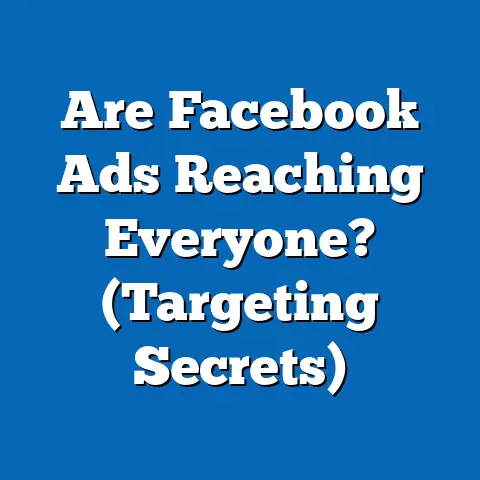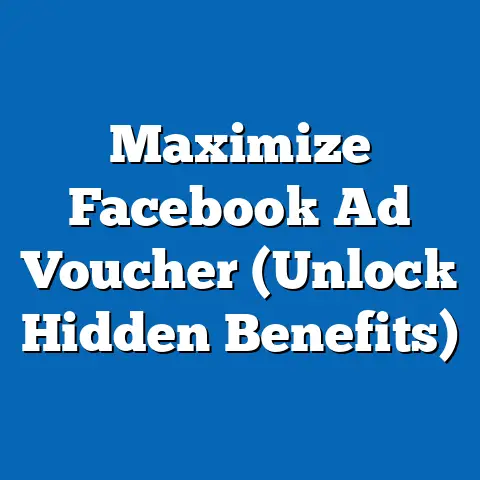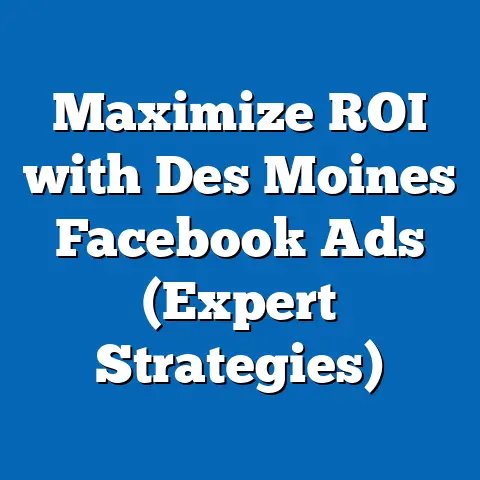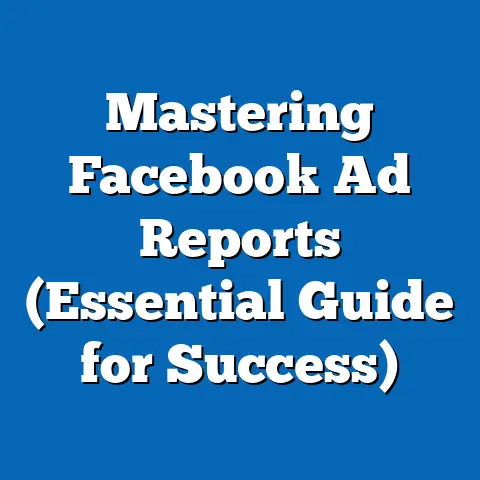Master Facebook Ads Conversions (Proven Strategies Revealed)
I remember the first time I dove into Facebook Ads. It felt like throwing spaghetti at a wall, hoping something would stick. I was spending money, but the results were…well, let’s just say my ROI was less than impressive. I saw glimpses of potential, stories of businesses booming thanks to targeted ads, but I couldn’t seem to crack the code.
Then, I met Sarah. Sarah owned a small online boutique, selling handmade jewelry. She was on the verge of closing shop. Her Facebook Ads were bleeding her dry; she was getting clicks, but no sales. Her engagement was abysmal, and her conversion rates were practically non-existent. She was frustrated, discouraged, and ready to give up.
But Sarah didn’t give up. She started digging, learning, and experimenting. She immersed herself in Facebook Ads strategy, devoured every article and webinar she could find, and connected with other marketers. She discovered the power of precise targeting, compelling ad copy, and visually stunning creatives.
The turning point came when she revamped her entire approach. She started by deeply understanding her ideal customer – their interests, their pain points, their aspirations. She then crafted ad copy that spoke directly to those needs, using emotional triggers and a clear call to action. And she invested in professional-quality photos of her jewelry, showcasing their unique beauty and craftsmanship.
If you’re struggling with low engagement, poor conversion rates, or wasted ad spend, know that you’re not alone. But with the right knowledge and a strategic approach, you can unlock the immense potential of Facebook Ads and achieve remarkable success. Let’s dive in and transform your Facebook Ads strategy together!
Understanding Facebook Ads
Facebook Ads are more than just pretty pictures and catchy slogans. They’re a powerful tool that, when wielded correctly, can connect your business with millions of potential customers worldwide. But before you start throwing money at ads, it’s crucial to understand what Facebook Ads are, why they matter, and how they fit into the broader digital marketing landscape.
What are Facebook Ads?
Facebook Ads are paid advertisements that appear on Facebook, Instagram, Messenger, and the Audience Network (a network of websites and apps that partner with Facebook). These ads can take various forms, from simple image ads to engaging video ads and interactive experiences. They allow businesses to target specific audiences based on demographics, interests, behaviors, and more.
Think of them as digital billboards, but instead of being placed on the side of a highway, they’re placed directly in front of your target audience as they scroll through their newsfeeds.
Why are Facebook Ads Significant?
In today’s digital world, Facebook Ads are a cornerstone of effective marketing. Here’s why:
- Massive Reach: Facebook boasts billions of active users worldwide, making it one of the largest social media platforms on the planet. This sheer scale provides unparalleled reach for your advertising campaigns.
- Precise Targeting: Facebook’s advanced targeting capabilities allow you to reach specific audiences based on their demographics, interests, behaviors, and even their past interactions with your business. This level of precision ensures that your ads are seen by the people most likely to be interested in your products or services. I’ve seen campaigns where simply refining the targeting parameters doubled the conversion rate.
- Diverse Ad Formats: Facebook offers a wide range of ad formats to suit different marketing objectives, from driving website traffic to generating leads and boosting app installs. This versatility allows you to create engaging and effective ads that resonate with your target audience.
- Measurable Results: Facebook Ads Manager provides detailed analytics and reporting tools that allow you to track the performance of your campaigns in real-time. This data-driven approach enables you to optimize your ads for maximum ROI.
- Cost-Effective: Compared to traditional advertising methods, Facebook Ads can be a cost-effective way to reach a large and targeted audience. You have control over your budget and can adjust your spending based on performance.
Types of Facebook Ads
Facebook offers a diverse range of ad formats to suit different marketing objectives and target audiences. Here’s a breakdown of some of the most common types:
- Image Ads: These are the simplest and most common type of Facebook Ad. They consist of a single image, ad copy, and a call-to-action button. Image ads are effective for capturing attention and conveying a clear message. I’ve found that high-quality, visually appealing images perform best.
- Video Ads: Video ads are a more engaging and interactive format that can effectively tell your brand’s story and showcase your products or services. They can be used to drive brand awareness, generate leads, or promote sales. Short, attention-grabbing videos tend to perform best on Facebook.
- Carousel Ads: Carousel ads allow you to showcase multiple images or videos within a single ad. This format is ideal for highlighting different features of a product, showcasing a range of products, or telling a sequential story. I’ve seen carousel ads work wonders for e-commerce businesses.
- Slideshow Ads: Slideshow ads are similar to video ads but use a series of still images or videos to create a dynamic visual experience. They’re a cost-effective way to create engaging video-like content without the expense of producing a full video.
- Collection Ads: Collection ads are designed for e-commerce businesses and allow you to showcase a selection of products in a visually appealing format. They typically feature a main image or video above a collection of product images.
- Lead Ads: Lead ads are designed to generate leads directly on Facebook. They allow users to submit their contact information without leaving the platform. This format is ideal for collecting email addresses, phone numbers, and other valuable information.
- Instant Experience Ads: Instant Experience ads (formerly known as Canvas Ads) are full-screen, mobile-optimized ads that provide an immersive and interactive experience for users. They can include images, videos, carousels, and other engaging elements.
- Messenger Ads: Messenger ads appear in the Facebook Messenger app and can be used to drive traffic to your website, generate leads, or start conversations with potential customers.
Facebook Ads Ecosystem
Understanding the Facebook Ads ecosystem is crucial for creating and managing successful campaigns. Here are some key components:
- Facebook Business Manager: This is the central hub for managing your Facebook Ads accounts, pages, and other business assets. It allows you to grant access to team members, track performance, and manage your overall advertising strategy.
- Facebook Ads Manager: This is the tool you’ll use to create, manage, and analyze your Facebook Ads campaigns. It provides a user-friendly interface for setting up your campaigns, targeting your audience, creating your ads, and tracking your results.
- Facebook Pixel: The Facebook Pixel is a snippet of code that you place on your website to track user actions, such as website visits, page views, and purchases. This data is used to optimize your ads for conversions and create retargeting audiences. I can’t stress enough how important the pixel is. Without it, you’re flying blind.
- Facebook Catalog: If you’re an e-commerce business, you can use the Facebook Catalog to upload your product inventory and create dynamic ads that showcase your products to potential customers.
Key Takeaway: Facebook Ads are a powerful and versatile tool that can help businesses reach a large and targeted audience. Understanding the different types of ads, the Facebook Ads ecosystem, and the importance of pixel tracking is essential for creating successful campaigns.
Next Step: Familiarize yourself with the Facebook Business Manager and Ads Manager interfaces. Set up your Facebook Pixel and install it on your website.
The Psychology of Conversions
Advertising isn’t just about showing your product to as many people as possible. It’s about understanding why people buy. It’s about tapping into their emotions, their needs, and their desires. Understanding the psychology of conversions is the key to crafting Facebook Ads that not only grab attention but also drive action.
Understanding Consumer Behavior on Social Media
Social media is a unique environment. People are scrolling through their feeds, connecting with friends and family, and consuming content for entertainment and information. They’re not actively searching for products or services (at least, not consciously). This means your ads need to be highly relevant, engaging, and non-intrusive to capture their attention.
Think about your own behavior on social media. What makes you stop scrolling? What makes you click on an ad? Chances are, it’s something that resonates with you on a personal level, something that sparks your interest, or something that solves a problem you’re facing.
The AIDA Model
The AIDA model is a classic marketing framework that describes the four stages of the consumer buying process:
- Attention: The first step is to grab the user’s attention. This can be achieved through eye-catching visuals, compelling headlines, or intriguing ad copy.
- Interest: Once you’ve captured their attention, you need to pique their interest by providing relevant and engaging information. Highlight the benefits of your product or service and explain how it can solve their problem.
- Desire: Next, you need to create a desire for your product or service. Show them how it can improve their lives, make them happier, or help them achieve their goals.
- Action: The final step is to prompt them to take action, such as visiting your website, making a purchase, or signing up for your email list. Use a clear and compelling call-to-action to guide them towards the desired outcome.
I often use the AIDA model as a checklist when crafting ad copy. Does my ad grab attention? Does it generate interest? Does it create desire? Does it have a clear call to action? If the answer to any of these questions is “no,” then I need to revise my ad.
Emotional Triggers
Emotions are powerful drivers of human behavior. Tapping into the right emotional triggers can significantly increase your conversion rates. Here are some common emotional triggers that work well in Facebook Ads:
- Urgency: Creating a sense of urgency can motivate people to take action quickly. Use phrases like “Limited time offer,” “Sale ends soon,” or “While supplies last.”
- Scarcity: Similar to urgency, scarcity implies that your product or service is in limited supply. Use phrases like “Only a few left,” “Exclusive offer,” or “Limited edition.”
- Social Proof: People are more likely to buy something if they see that others have had positive experiences with it. Use testimonials, reviews, and case studies to build social proof.
- Fear of Missing Out (FOMO): FOMO is the feeling of anxiety that you’re missing out on something exciting or valuable. Use phrases like “Don’t miss out,” “Join the movement,” or “Be part of the community.”
- Happiness: People are naturally drawn to things that make them happy. Use images and videos that evoke positive emotions and highlight the joyful experiences associated with your product or service.
- Belonging: People have a strong desire to belong to a community or group. Use phrases like “Join our family,” “Become a member,” or “Connect with like-minded people.”
Examples of Successful Campaigns Using Psychological Principles
- Dollar Shave Club: Their viral video ad used humor and relatable pain points to capture attention and create a desire for their affordable shaving products.
- Airbnb: Their ads often feature stunning images of unique accommodations and highlight the opportunity to experience new cultures and connect with local hosts, tapping into the desire for adventure and belonging.
- Amazon Prime: Their ads emphasize the convenience and benefits of Prime membership, such as free shipping and exclusive deals, creating a fear of missing out on valuable savings.
Key Takeaway: Understanding the psychology of conversions is crucial for crafting effective Facebook Ads. By applying the AIDA model and tapping into emotional triggers, you can create ads that resonate with your target audience and drive action.
Next Step: Analyze your target audience and identify the emotional triggers that are most likely to motivate them. Incorporate these triggers into your ad copy and visuals.
Crafting Irresistible Ad Copy
Ad copy is the heart and soul of your Facebook Ads. It’s the words that capture attention, pique interest, create desire, and ultimately drive conversions. Writing compelling ad copy is an art and a science, and it requires a deep understanding of your target audience and the principles of persuasive writing.
A Framework for Writing Compelling Ad Copy
Here’s a framework I use to write ad copy that converts:
- Know Your Audience: Before you start writing, take the time to understand your target audience. What are their needs, their pain points, their aspirations? What language do they use? What are their values? The more you know about your audience, the better you’ll be able to craft ad copy that resonates with them.
- Start with a Strong Hook: Your hook is the first sentence or phrase that grabs the user’s attention and makes them want to learn more. It should be intriguing, relevant, and benefit-driven.
- Highlight the Value Proposition: Your value proposition is the unique benefit that your product or service offers. It should clearly explain why someone should choose you over the competition.
- Address Pain Points: Identify the problems that your target audience is facing and explain how your product or service can solve those problems.
- Use Emotional Language: As we discussed earlier, emotions are powerful drivers of human behavior. Use emotional language to connect with your audience on a personal level and create a desire for your product or service.
- Build Credibility: Build trust and credibility by using social proof, such as testimonials, reviews, and case studies.
- Include a Clear Call-to-Action (CTA): Your CTA should clearly tell the user what you want them to do next. Use action-oriented verbs like “Shop Now,” “Learn More,” “Sign Up,” or “Get Started.”
- Keep it Concise: People have short attention spans, especially on social media. Keep your ad copy concise and to the point. Use short sentences and paragraphs and avoid jargon or technical terms.
- Test and Optimize: Don’t be afraid to experiment with different ad copy variations. Use A/B testing to see what works best and continuously optimize your ad copy for maximum performance.
The Importance of a Strong Hook
The hook is your first (and often only) chance to capture the user’s attention. It needs to be compelling enough to make them stop scrolling and read the rest of your ad. Here are some examples of effective hooks:
- Question: “Tired of struggling with [problem]?”
- Statistic: “90% of [target audience] experience [problem].”
- Benefit: “Finally, a [product/service] that helps you [achieve desired outcome].”
- Intrigue: “The secret to [achieving desired outcome] that nobody is talking about.”
- Controversy: “Why everything you know about [topic] is wrong.”
Storytelling Techniques
Storytelling is a powerful way to engage your audience and create an emotional connection. People are naturally drawn to stories, and they’re more likely to remember and share them. Here are some tips for using storytelling techniques in your ad copy:
- Tell a relatable story: Share a story about a customer who benefited from your product or service.
- Use vivid language: Paint a picture with your words and help the reader visualize the benefits of your product or service.
- Create a sense of empathy: Show that you understand the reader’s pain points and challenges.
- Build suspense: Keep the reader engaged by building suspense and revealing the outcome gradually.
- End with a strong message: Leave the reader with a lasting impression and a clear call to action.
I remember one campaign I ran for a local bakery. Instead of just showing pictures of their cakes, we told the story of how their founder, a grandmother, started baking with her grandchildren. We highlighted the love and passion that went into each cake, and the ads resonated deeply with the community.
Examples of High-Performing Ad Copy
- “Stop wasting time on tedious tasks. Automate your workflow with [software] and reclaim your day! Get a free trial now.” (This ad uses a clear hook, highlights the value proposition, and includes a strong call to action.)
- “Are you tired of feeling stressed and overwhelmed? Discover the power of mindfulness with our guided meditation app. Download now and start your journey to inner peace.” (This ad addresses a pain point, uses emotional language, and includes a clear call to action.)
- “Don’t miss out on our biggest sale of the year! Save up to 50% on all [products] for a limited time only. Shop now and stock up on your favorites.” (This ad creates a sense of urgency and scarcity and includes a clear call to action.)
Key Takeaway: Crafting irresistible ad copy is essential for driving conversions on Facebook Ads. By understanding your audience, using a strong hook, highlighting the value proposition, and incorporating storytelling techniques, you can create ads that capture attention, pique interest, and ultimately drive action.
Next Step: Review your existing ad copy and identify areas for improvement. Use the framework outlined above to rewrite your ad copy and make it more compelling and persuasive.
Targeting Your Audience
Imagine you’re opening a lemonade stand. Would you set it up in the middle of the desert? Of course not! You’d set it up in a busy park on a hot day. The same principle applies to Facebook Ads. Targeting the right audience is crucial for ensuring that your ads are seen by the people most likely to be interested in your products or services.
The Significance of Audience Targeting
Audience targeting is the process of identifying and reaching specific groups of people with your advertising message. It allows you to focus your ad spend on the people who are most likely to convert, rather than wasting money on a broad audience that may not be interested in what you have to offer.
Think of it as precision marketing. Instead of casting a wide net, you’re using a fishing rod to target specific fish in the sea.
Targeting Options Available on Facebook
Facebook offers a wide range of targeting options to help you reach your ideal customer. Here are some of the most common:
- Demographics: Target people based on their age, gender, location, education, relationship status, and other demographic factors.
- Interests: Target people based on their interests, hobbies, and passions. Facebook gathers this information from the pages they like, the groups they join, and the content they interact with.
- Behaviors: Target people based on their online behaviors, such as their purchase history, the websites they visit, and the apps they use.
- Custom Audiences: Create custom audiences based on your own data, such as your email list, website visitors, or app users. This allows you to retarget people who have already interacted with your business.
- Lookalike Audiences: Create lookalike audiences based on your existing custom audiences. Facebook will identify people who share similar characteristics and behaviors with your best customers.
- Saved Audiences: Combine multiple targeting options to create a saved audience that you can use for future campaigns.
I often start by creating a broad audience based on demographics and interests. Then, I use A/B testing to refine my targeting and identify the most responsive segments.
Creating Buyer Personas
A buyer persona is a semi-fictional representation of your ideal customer. It’s based on research and data about your existing customers and target audience. Creating buyer personas can help you better understand your customers’ needs, pain points, and motivations.
Here are some questions to consider when creating your buyer personas:
- What is their age, gender, and location?
- What is their occupation and income level?
- What are their interests and hobbies?
- What are their goals and aspirations?
- What are their pain points and challenges?
- What are their values and beliefs?
- Where do they spend their time online?
Once you’ve created your buyer personas, you can use them to inform your targeting strategy. Target your ads to the demographics, interests, and behaviors that align with your buyer personas.
Case Studies of Improved Conversion Rates Through Precise Targeting
- E-commerce Business: An e-commerce business selling organic baby clothing improved their conversion rates by 30% by targeting parents who were interested in organic products and had recently purchased baby products online.
- Software Company: A software company selling project management software improved their lead generation by 50% by targeting project managers who were using competitor software.
- Local Restaurant: A local restaurant improved their foot traffic by 20% by targeting people who lived within a 5-mile radius of the restaurant and were interested in dining out.
Key Takeaway: Targeting the right audience is crucial for maximizing your conversion rates on Facebook Ads. By understanding the various targeting options available, creating buyer personas, and continuously refining your targeting strategy, you can ensure that your ads are seen by the people most likely to be interested in your products or services.
Next Step: Create buyer personas for your ideal customers. Use these personas to inform your targeting strategy and create targeted audiences in Facebook Ads Manager.
Designing Eye-Catching Visuals
In the fast-paced world of social media, visuals are king. Your ad’s visual is often the first thing people see, and it plays a crucial role in capturing their attention and driving conversions. High-quality, visually appealing visuals can make the difference between an ad that’s ignored and an ad that’s clicked on.
The Role of Visuals in Capturing Attention and Driving Conversions
Think about your own experience scrolling through Facebook. What makes you stop and look at an ad? Chances are, it’s the visual. Whether it’s a stunning image, an engaging video, or an eye-catching graphic, the visual is what draws you in and makes you want to learn more.
Visuals are also essential for conveying your message quickly and effectively. People process visual information much faster than text, so a well-designed visual can communicate your value proposition in a matter of seconds.
Best Practices for Creating High-Quality Images and Videos
Here are some best practices for creating high-quality images and videos for Facebook Ads:
- Use high-resolution images and videos: Blurry or pixelated visuals can make your ads look unprofessional and untrustworthy.
- Choose relevant visuals: Your visuals should be relevant to your product or service and appeal to your target audience.
- Use bright and vibrant colors: Colors can evoke emotions and capture attention. Use bright and vibrant colors that align with your brand and message.
- Include a clear call to action: Make it easy for people to understand what you want them to do next. Include a clear call to action in your visual, such as “Shop Now,” “Learn More,” or “Sign Up.”
- Optimize for mobile: Most people access Facebook on their mobile devices, so make sure your visuals are optimized for mobile viewing.
- Test different visuals: Experiment with different images and videos to see what works best. Use A/B testing to compare the performance of different visuals and optimize your ads accordingly.
I’ve found that using images of real people using the product often performs better than generic stock photos. It helps build trust and makes the product more relatable.
The Importance of Branding Consistency
Branding consistency is crucial for building brand recognition and trust. Your Facebook Ads visuals should align with your overall brand identity, including your logo, colors, fonts, and messaging.
When your ads consistently reflect your brand, people are more likely to recognize and remember your brand. This can lead to increased brand awareness, customer loyalty, and ultimately, conversions.
Examples of Visually Appealing Ads
- Nike: Nike’s ads often feature stunning images of athletes in action, showcasing the performance and style of their products.
- Apple: Apple’s ads are known for their minimalist design and focus on the product’s features and benefits.
- Dove: Dove’s ads often feature real women of all shapes and sizes, promoting body positivity and self-acceptance.
Key Takeaway: Designing eye-catching visuals is essential for capturing attention and driving conversions on Facebook Ads. By using high-quality images and videos, maintaining branding consistency, and continuously testing different visuals, you can create ads that resonate with your target audience and achieve your marketing goals.
Next Step: Review your existing Facebook Ads visuals and identify areas for improvement. Use the best practices outlined above to create new visuals that are more engaging, relevant, and consistent with your brand.
Analyzing and Optimizing Performance
Creating great ads and targeting the right audience is only half the battle. The real magic happens when you start analyzing your ad performance and optimizing your campaigns for maximum conversions. Data is your best friend in the world of Facebook Ads.
The Importance of Tracking and Analyzing Ad Performance
Tracking and analyzing your ad performance allows you to understand what’s working and what’s not. It helps you identify areas for improvement and make data-driven decisions to optimize your campaigns for better results.
Without tracking and analysis, you’re essentially flying blind. You’re spending money on ads without knowing whether they’re actually driving conversions.
Key Metrics to Monitor
Here are some key metrics to monitor in Facebook Ads Manager:
- Impressions: The number of times your ad was displayed to users.
- Reach: The number of unique users who saw your ad.
- Click-Through Rate (CTR): The percentage of users who clicked on your ad after seeing it. A high CTR indicates that your ad is relevant and engaging.
- Cost Per Click (CPC): The average cost you pay each time someone clicks on your ad.
- Conversion Rate: The percentage of users who completed a desired action (e.g., made a purchase, signed up for a newsletter) after clicking on your ad.
- Cost Per Conversion (CPC): The average cost you pay for each conversion.
- Return on Ad Spend (ROAS): The amount of revenue you generate for every dollar you spend on advertising.
I like to create custom dashboards in Facebook Ads Manager to track the metrics that are most important to my business. This allows me to quickly see how my campaigns are performing and identify any areas that need attention.
A/B Testing
A/B testing (also known as split testing) is a method of comparing two versions of an ad to see which one performs better. You can A/B test different elements of your ad, such as the headline, the ad copy, the visual, or the call to action.
To conduct an A/B test, create two versions of your ad with slight variations. Run both ads simultaneously and track their performance. The ad with the higher conversion rate is the winner.
A/B testing is an iterative process. Once you’ve identified a winning ad, you can create new variations to test against it and continuously improve your performance.
Actionable Steps for Continuous Optimization
Here are some actionable steps for continuously optimizing your Facebook Ads campaigns:
- Monitor your key metrics regularly: Check your ad performance data at least once a week (or even daily) to identify any trends or anomalies.
- Identify underperforming ads: Pause or revise ads that are not performing well.
- Experiment with different targeting options: Try targeting different demographics, interests, or behaviors to see if you can improve your results.
- Test different ad copy and visuals: Use A/B testing to compare different ad copy and visuals and identify the most effective combinations.
- Optimize your landing page: Make sure your landing page is relevant to your ad and provides a seamless user experience.
- Track your conversions: Use the Facebook Pixel to track your conversions and understand which ads are driving the most sales or leads.
- Scale successful campaigns: Once you’ve identified a winning campaign, increase your budget to reach a wider audience and generate even more conversions.
Key Takeaway: Analyzing and optimizing your ad performance is essential for maximizing your conversions on Facebook Ads. By tracking key metrics, conducting A/B tests, and continuously refining your campaigns, you can achieve better results and get the most out of your advertising budget.
Next Step: Start tracking your Facebook Ads performance data. Identify underperforming ads and experiment with different targeting options, ad copy, and visuals to improve your results.
Conclusion
Remember Sarah, the online boutique owner from the beginning? By implementing the strategies we’ve discussed – understanding her audience, crafting compelling copy, using eye-catching visuals, and meticulously analyzing her results – she transformed her struggling business into a thriving one. Her Facebook Ads went from a drain on her resources to a powerful engine for growth.
Mastering Facebook Ads is not a one-time event; it’s a continuous journey of learning, testing, and adapting. The Facebook Ads platform is constantly evolving, with new features and targeting options being added all the time. It’s important to stay up-to-date on the latest trends and best practices to remain competitive.
The strategies I’ve shared are proven to work, but they’re not a magic bullet. You’ll need to put in the work to implement them effectively and tailor them to your specific business and target audience.
I encourage you to take the first step today. Start by reviewing your existing Facebook Ads campaigns and identifying areas for improvement. Use the knowledge you’ve gained from this guide to craft more compelling ad copy, design more eye-catching visuals, and target your audience more precisely.
Unlock your potential for success with Facebook Ads. Transform your advertising strategy and watch your conversions soar! Don’t just take my word for it. Test these strategies, analyze your results, and see the difference for yourself. The power to transform your business is in your hands. Take action and start your journey to Facebook Ads mastery today!

